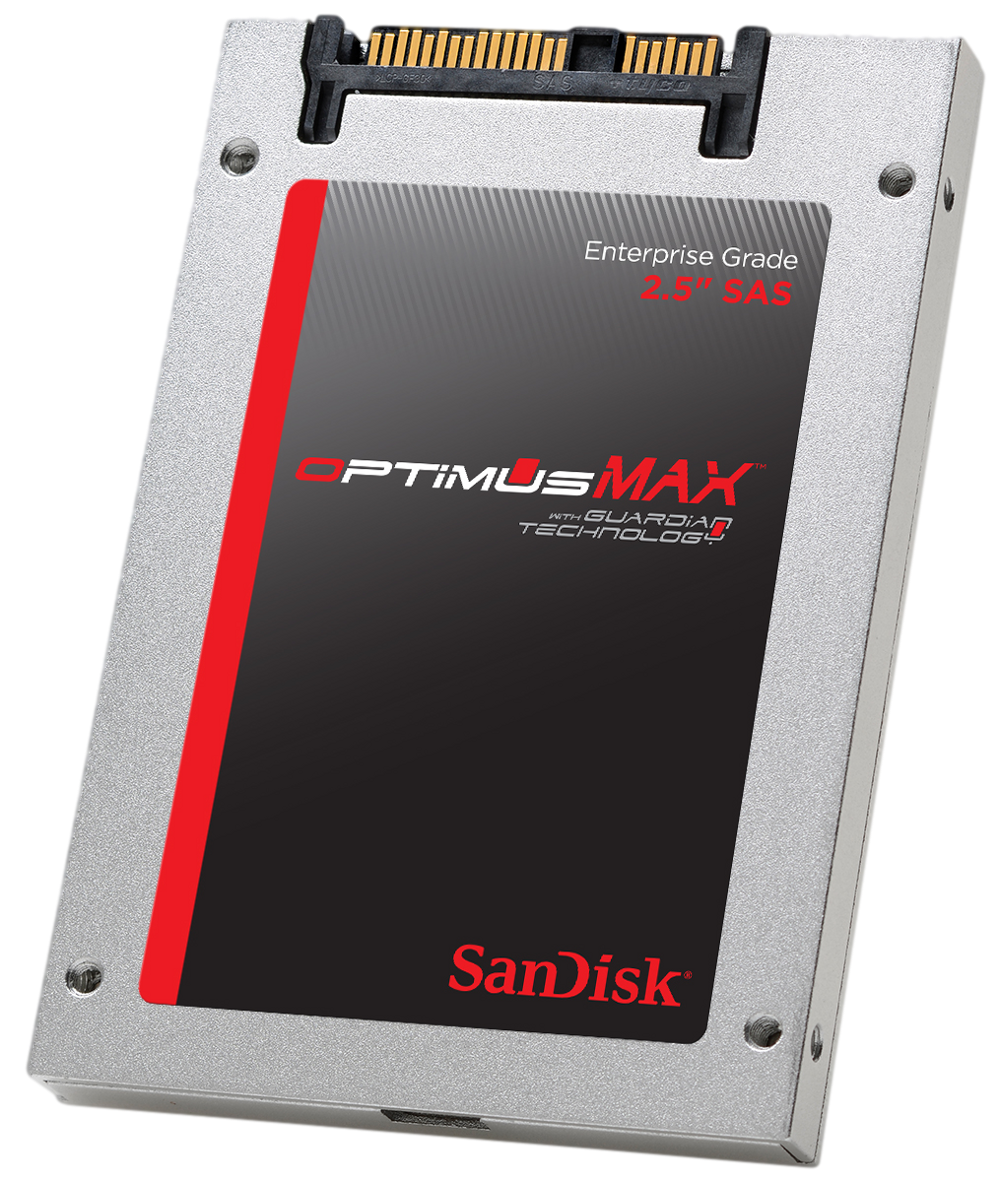SanDisk Corporation, a world-leading producer of flash storage devices, is announcing its new Optimus MAX Serial Attached SCSI (SAS) solid state drive (SSD), representing the world’s first 4TB SAS SSD. SanDisk’s Optimus MAX offers storage capacity that even exceeds the current highest-capacity 2.5″ 10,000 rpm and 15,000 rpm SAS hard disk drives (HDDs), creating the first true replacement for legacy data center SAS HDDs. With the Opitmus MAX SSD, SanDisk is able to deliver SAS-level performance and functionality at a significantly reduced price point comparable to SATA-based SSDs. The Optimus MAX is the centerpoint of SanDisk’s newly refreshed Optimus family of SSDs.
According to John Scarramuzzo, Senior Vice President and General Manager of Enterprise Storage Solutions at SanDisk, “Customers have been looking for a way to transition their data centers from HDDs to NAND flash, but have been forced to decide between cost and performance, or give up important functionality. The Optimus MAX eliminates the need for compromises. We believe that the Optimus MAX will be a disruptive force within the storage industry, catalyzing many organizations to make the switch from their HDD-prominent data center infrastructures to SSDs.”
Companies have historically depended on 10,000 rpm and 15,000 rpm SAS HDDs for mission-critical enterprise usage scenarios as they provided relatively high performance at a relatively low cost. As the sheer volume of data explodes, and as real time access to that data becomes increasingly important, IT departments are finding that traditional HDDs aren’t meeting usage demands. Enter the Optimus MAX SSD, offering an alternative that is cost-effective for high-density storage with SSD-class performance and reliability, allowing enterprise users to replace under-performing HDDs while still leveraging their present SAS storage infrastructures. By utilizing the Optimus MAX SSD, enterprise users will experience dramatic reductions in infrastructure expenses –fewer racks, fewer power supplies, fewer HBAs, etc. This results in lower capital expenditure costs, significantly reduced footprint and power requirements, and other cost reductions that are reflected in total cost of ownership (TCO).
Laura Dubois, Program Vice President for IDC’s storage practice, observes that “Currently, SSDs are used to accentuate high-capacity HDDs in traditional enterprise, cloud and hyperscale data centers, however, increasing numbers of IT managers are finding that they need accelerated performance. As SSDs, such as SanDisk’s new Optimus MAX, continue to increase in capacity while achieving greater cost-effectiveness, more enterprises will look to SSDs to replace their legacy HDD infrastructures in order to meet today’s high I/O applications and enterprise workload requirements.”
As with the entire SanDisk Optimus SSD lineup, the Optimus MAX SSD features Sandisk’s proprietary Guardian Technology Platform, comprised of FlashGuard, DataGuard, and EverGuard technologies that work together to provide a potent blend of powerful error correction and detection capabilities, full data path protection, and power loss data fail recovery, and is able to do so from lower-cost MLC NAND flash. The Optimus MAX SSD is able to offer enterprise users the performance, consistent reliability, and extended lifespan required for read-intensive workloads.
SanDisk is also announcing that they have updated the entire Optimus family of SSDs to the latest 19nm MLC NAND flash and its attendant benefits. The previous Optimus SSD has been renamed as teh Optimus Ascend SSD, while the Optimus Ultra SSD has been redesignated as the Optimus Extreme SSD. Endurance capabilities of the Optimus lineup is as follows (expressed in drive writes per day (DWPD)):
- Optimus MAX SSD (1-3 full DWPD)
- Optimus ECO SSD (1-3 full DWPD)
- Optimus Ascend SSD (10 full DWPD)
- Optimus Ultra SSD (25 full DWPD)
- Optimus Extreme SSD (45 full DWPD)
By virtue of this product lineup refreshing, the Optimus SSD series delivers a single SAS platform that is capable of addressing a wide range of enterprise usage scenarios by offering varying combinations of capacity, performance and endurance. The Optimus MAX and other Optimus SSD renewals will be available with SanDisk’s TCG (Trusted Computing Group) Enterprise Security Subsystem Class compliance to certain OEMs, and via channel partners in Q3 of 2014.
You can view SanDisk’s product page for the Optimus MAX SAS SSD here; and the SanDisk press release on the Optimus MAX can be viewed in its entirety here.
 The SSD Review The Worlds Dedicated SSD Education and Review Resource |
The SSD Review The Worlds Dedicated SSD Education and Review Resource | 


I wonder what controller they are using, to adress so much flash.
Also.. Are they stacking 16 dies per package or is this moster packing 32 packages ? 🙂